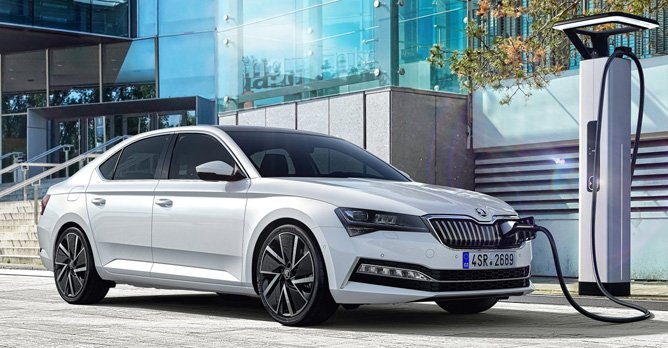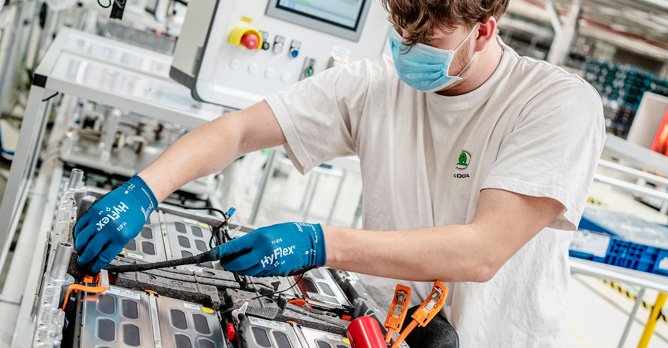Skoda hits milestone of 100,000 hybrid batteries for its plug-in hybrid models
14 Feb 2021|1,147 views
Skoda has manufactured its 100,000th high-voltage traction battery. In order to create the necessary production conditions for its headquarters in Mlada Boleslav, Skoda invested approximately $40.67 million in 2019.
An area covering roughly 2,000m2 is now used not only to produce high-voltage traction batteries for Skoda's own plug-in hybrid models, but also batteries for plug-in hybrids from the Volkswagen Group brands including Audi and Seat. The site also boasts state-of-the-art facilities to comprehensively test the batteries and ensure the highest possible safety and quality standards.
Production of the high-voltage traction batteries at the Mlada Boleslav site commenced in September 2019, and has since been gradually scaled up. It takes approximately two hours to manufacture a battery, during which it passes through 66 different workstations. Every 88 seconds, a battery for MQB-based models with plug-in hybrid drivetrain rolls off the production line.
Each shift sees 58 employees working, with heavy or awkward components being handled by a total of 13 robots. They are designed for weights ranging between 210kg to 500kg and feed the battery modules into the production line, or load the finished battery systems onto pallets.
On the production line, the modules for the left and right halves of a battery pack are processed separately. They are provided with a special heat-conducting film, which dissipates heat and helps to cool the assembled battery system.
In addition, a liquid coolant is added between the two modules before they are joined in a solid aluminium housing. All is then prepared for the battery to be installed into the vehicle. Besides the electronics, the battery pack is also provided with all the necessary cable bundles, seals and brackets.

Once the leak test has been performed, the electrical functions are assessed on a total of 13 test benches. This includes, for example, the interaction of high-voltage and low-voltage components as well as a test of the electrical insulation. Finally, each battery system is charged to a portion of its maximum capacity.
Skoda has manufactured its 100,000th high-voltage traction battery. In order to create the necessary production conditions for its headquarters in Mlada Boleslav, Skoda invested approximately $40.67 million in 2019.
An area covering roughly 2,000m2 is now used not only to produce high-voltage traction batteries for Skoda's own plug-in hybrid models, but also batteries for plug-in hybrids from the Volkswagen Group brands including Audi and Seat. The site also boasts state-of-the-art facilities to comprehensively test the batteries and ensure the highest possible safety and quality standards.
Production of the high-voltage traction batteries at the Mlada Boleslav site commenced in September 2019, and has since been gradually scaled up. It takes approximately two hours to manufacture a battery, during which it passes through 66 different workstations. Every 88 seconds, a battery for MQB-based models with plug-in hybrid drivetrain rolls off the production line.
Each shift sees 58 employees working, with heavy or awkward components being handled by a total of 13 robots. They are designed for weights ranging between 210kg to 500kg and feed the battery modules into the production line, or load the finished battery systems onto pallets.
On the production line, the modules for the left and right halves of a battery pack are processed separately. They are provided with a special heat-conducting film, which dissipates heat and helps to cool the assembled battery system.
In addition, a liquid coolant is added between the two modules before they are joined in a solid aluminium housing. All is then prepared for the battery to be installed into the vehicle. Besides the electronics, the battery pack is also provided with all the necessary cable bundles, seals and brackets.

Once the leak test has been performed, the electrical functions are assessed on a total of 13 test benches. This includes, for example, the interaction of high-voltage and low-voltage components as well as a test of the electrical insulation. Finally, each battery system is charged to a portion of its maximum capacity.
Latest COE Prices
September 2025 | 2nd BIDDING
NEXT TENDER: 08 Oct 2025
CAT A$119,003
CAT B$136,890
CAT C$72,501
CAT E$140,502
View Full Results Thank You For Your Subscription.




















